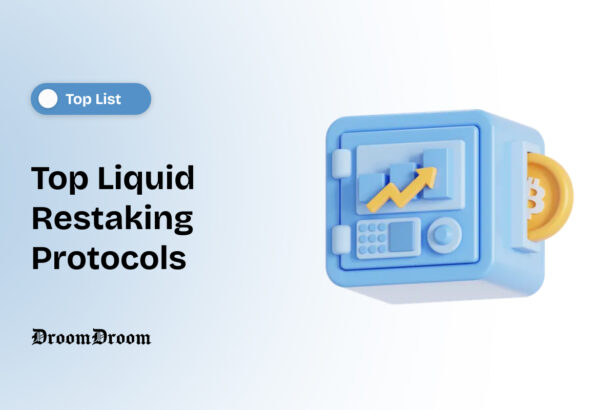The crypto space has provided its users with various ways to ensure passive income. One of the most promising methods is Liquid Restaking, which has gained significant popularity among blockchain enthusiasts. Top Liquid Restaking Protocols are appealing to those who have begun or are planning to start investing in digital assets. However, investing in a complex system like this isn’t easy; in fact, it can be quite confusing for beginners. Thus, it is essential to understand how the entire concept works.
For the uninitiated, Liquid Restaking is a process of reinvesting Liquid Staking Tokens (LSTs) for various purposes while generating income from them. Investors can place these tokens into external systems and continue earning yields. Furthermore, repurposing the staked tokens does not compromise their security; they remain decentralized and robust at their core. Due to these valuable advantages, liquid restaking is gaining popularity day by day.
To grasp liquid restaking, it’s important to understand the basics. Before learning about restaking, it’s necessary to comprehend staking first and become thoroughly familiar with its consensus mechanism. Numerous specifics are involved in the operations of restaking, from validating transactions to creating new blocks, everything functions in a particular way. So, let’s dig deeper into the concept of liquid restaking and discover what it’s all about
Understanding Liquid Restaking
Stating the obvious, it works on the Proof-of-Stake (PoS) consensus mechanism. The basics of the mechanism are just like staking, users lock their tokens to participate in the network. The bigger the size, the more their chances to become validators and block creators. In exchange for their commitment, the participants earn rewards as interest on the staked assets. Now, this is what a staking protocol does by design.
Liquid restaking takes the whole thing one level further. The base element of this structure is the Liquid Staking Token. These tokens are liquid in nature and are made for utilization in the DeFi space. Holders can use them for a variety of DeFi platforms for different reasons. What differentiates restaking from staking is their purpose and process. Restaking exclusively uses the tokens for reinvesting. It focuses on raising potential earnings as well as liquidity.
Here’s How Liquid Restaking Works
As mentioned above, liquid restaking takes the concept of staking further. It escalates the overall functionality as well as the merits of staking. In staking, investors secure their holding in the network and receive liquid tokens for it. Restaking turns these LSTs into Liquid Staking Derivatives (LSDs). These derivatives make the entry into the staking network. It eliminates the requisite of a minimum of 32 ETH.
Once the process of restaking begins, the tokens get involved in additional yield-generating activities. The initiation of the procedure starts with the issuance of a new token, the Liquid Restaking Token (LRT). This token represents the original staked assets while extending their potential for earning. It increases their subsequent investments and boosts their returns. Therefore, liquid restaking supports scalability and compounds earnings.
LRTs participate in assorted DeFi protocols without the need to unstake the assets. They secure new investment opportunities while ensuring the security of the network. Starting liquid restaking is easier if you break it down into subsequent steps.
- Crypto Staking: First of all, stake a certain portion of tokens in the network. This begins your participation in the network and lets you proceed with the subsequent tasks.
- Obtaining Tokens: Once the staking is done, you receive an LST token. This token lets you use and explore other services in the DeFi space
- Restaking: The same LST lets you embark on a restaking journey without requiring you to give up your staked coins.
Differentiating Liquid Restaking from Liquid Staking and Staking
The continuous progression of staking to its upgraded versions highlights the efforts put into the upheaval of the blockchain. Not only does it elevate capital efficiency, but it also boosts its potential to generate rewards. Here are some distinguishing features that set them apart from each other.
- Staking: The basic form of staking in which holders secure a certain number of their assets into the blockchain. It supports the operations of the network and ekes out rewards for the stakers.
- Liquid Staking: It gets more sophisticated as stakers get LSTs for their participation. These specific tokens allow the participants to enjoy liquidity and explore the DeFi markets.
- Liquid Restaking: It takes the whole thing one step ahead by investing LSTs into yield-generating activities. At the same time, it continues to enhance liquidity while amplifying the earning potential.
After getting familiar with the basics, let’s explore the top liquid restaking protocols right now.
Top Liquid Restaking Protocols for Crypto Users
The top Liquid Restaking Protocols projects have delivered advanced features and total value locked while maintaining a decent adoption rate.
Etherfi
With a TVL of $2.8 billion, Etherfi is currently the largest liquid restaking protocol. The platform leverages Ethereum’s PoS while allowing users to receive and stake ETH tokens. Maximizing rewards for the participants helps them partake in the growing DeFi ecosystem. Furthermore, it has partnered with EigenLayer to enable the stake to indulge in more ETH-based software modules.
EigenLayer
Developed on the Ethereum blockchain, EigenLayer is known for its innovative streak. Its TVL is over 1.5 billion, and it bolsters the overall security of the restaking structure. In addition to that, it allows ETH stakers to use their tokens on other decentralized applications, too. Simultaneously, it lets them earn more rewards by ensuring pooled security. It helps the participants to earn rewards from multiple protocols.
Pendle
Pendle focuses on trading yield and tokenization while letting users do more in the DeFi sphere. The project turns the yield-bearing assets into Yield tokens (YT) and Principal tokens (PT). Holders can trade these tokens on various applications. The mechanism lets participants manage the yield in a scalable way. They can use these tokens just like the regular tokens after doing all the market research.
Related topic: Top Penny Crypto Coins to Buy Before Bull Run In 2026
Restake Finance
Restake functions as a modular liquid staking protocol for EigenLayer. It is actually the first one designed for this job for a restaking platform. It has introduced the concept of rehypothecation. It allows the LSTs to boost cryptoeconomic security. Facilitating the validation system for EigenLayer, it lets users earn more. Moreover, Restake’s DAO ensures that the governance is always ethical.
Puffer Finance
Puffer works as a native liquid restaking protocol (nLRP). It capitalizes on the EigenLayer network while bringing PoS validation in the restaking process. Investors consider it a risk-free option because of its new module. The administrators of the network also monitor the governance system. This approach eases the depositing and receiving of ETH.
Also Read: Top Bitcoin Storage Errors and How to Protect Your Assets?
Renzo Protocol
Renzo operates as a Liquid Restaking Token (LRT) as well as a Strategy Manager for EigenLayer. With a TVL of over $1 billion, it plays a crucial role in EigenLayer’s interface. It amps up the yields and solves many problems that participants face in restaking. The protocol optimizes the connection between node operators and users. It allows permissionless activities and strengthens trust within the ecosystem.
Kelp DAO
Kelp DAO focuses on the scalability and liquidity of staked assets. The protocol makes liquid restaking solutions more accessible for public blockchain networks. It also facilitates the accrual of rewards while distributing the staked tokens among the node operators. With the support of 15,000 rsETH holders, Kelp DAO boasts over $628 million in TVL.
Swell Liquid Restaking
Swell enables users to earn Ethereum staking rewards and native restaking yield. It provides an LRT called rswETH that gives stakers access to EigenLayer. The participants of the restaking process get the incentives without giving up their liquidity. In terms of TVL, Swell boasts over $150 million. It facilitates Actively Validated Services (AVSs) while streamlining the whole network.
Also Read: Top AI Agents: 10 Best AI Agents Platforms for Blockchain you Must be Aware About
Things to Remember Before You Do Liquid Restaking
When evaluating top liquid restaking protocols, keep these important factors in mind:
- First of all, you need to look for protocols that support the cryptos you wish to stake.
- Also, check how good the network is with its overall security and smart contract audits.
- You must compare the rewards provided by different protocols before deciding on one.
- Keep on regulatory actions in the domain as it can impact the operations of restaking.
- Check if the protocol is involved with lending or borrowing activities. If it is, see their track record of fulfilling the obligations.
- The other risks include complex smart contract structure, liquidity of assets, and tokens losing their value.
Conclusion: Top Liquid Restaking Protocols
Top liquid restaking protocols bring a plethora of possibilities to the entire DeFi space. While advancing the staking mechanism, it also augments opportunities for earning for crypto users. With the rise of multiple platforms, it is also becoming more accessible. Of course, investors have to keep a few things in mind to make the most of this concept. If done strategically, it could be very fruitful for all blockchain enthusiasts.
Frequently Asked Questions
What are some top liquid restaking protocols in 2026?
Etherfi, EigenLayer, and Restake Finance are the top liquid restaking protocols that provide some great benefits to users. Etherfi is the largest protocol with $2.8 billion TVL, leveraging Ethereum’s PoS and DeFi ecosystem. EigenLayer is known for pooled security and innovative ETH staking solutions with $1.5 billion TVL. On the other hand, Restake Finance is a modular protocol focusing on rehypothecation and governance through DAOs.
What is liquid restaking and how does it differ from traditional staking?
Liquid restaking takes staking to the next level by allowing users to reinvest their Liquid Staking Tokens (LSTs) for additional yield-generating activities. Unlike traditional staking where tokens are simply locked in the network, liquid restaking enables investors to use their staked assets across various DeFi platforms through Liquid Restaking Tokens (LRTs), thus compounding their earnings while maintaining network security.
What risks should I consider before engaging in liquid restaking?
Before using top liquid restaking protocols, consider the protocol’s security measures and smart contract audits, compare reward rates across platforms, stay aware of regulatory developments, check if the protocol engages in lending or borrowing activities and their track record, and assess risks related to complex smart contract structures, asset liquidity, and potential token devaluation.




















